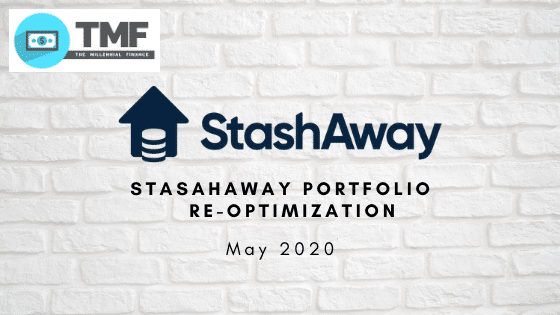Table of Contents
It’s here. The StashAway portfolio re-optimization has finally come. Adjusting our portfolio allocations depending on market conditions is what we’re paying StashAway for. Plus the convenience of depositing of course.
To be completely honest, I expected a quicker reaction to our 35% peak to trough decline since the pandemic hit. To be fair to them, what we just went through was one of the fastest and steepest declines we’ve endured since… I don’t even know when.
So, I’ll look past that and focus more on what has changed! For some reason, I get super excited when these changes are made. It’s nice to compare my personal outlook of the market versus what StashAway thinks. They’re obviously smarter and better informed than I am.
I’ll start off with the justification of their changes. If you’re already with StashAway, you should’ve gotten this email too. If you’re not, you can use our link to get 50% off your management fees waived for 6 months!
Note that this only impacts those who opted in for the auto re-optimizations such as myself. If you opted out of this, you’ll have the choice to decide whether you want to make the change or not. So read on!

1. Adjusted for valuation gaps
Basically, they’ve reduced or withdrawn investments in asset classes they feel are overvalued, and shifted these funds to assets that have smaller valuation gaps. Fair but let’s see what they thought was overvalued.
2. Decreased US Dollar Exposure
The Fed has been printing tons of money. StashAway doesn’t like this. StashAway feels it’ll devalue the US Dollar which will impact our returns (if USD devalues, our MYR value decreases too). It’s something that most people feel the same about as the increase in money supply will drive prices lower. Basic economics.
3. Introduced Chinese Technology as an asset class
They’ve included a new ETF (Chinese Internet $KWEB) and reintroduced the All Asia Except Japan ($AAXJ) ETF to their asset classes. This is in view of China as a country growing tremendously, and their probable undervaluation in comparison to US stocks.
4. Increased (or maintained) exposure to Gold
As a safe haven asset and protection against devaluing paper money, they’ve decided that the allocation of gold needs to be jacked up. Many institutions are doing the same in response to Fed Bazooka too. Bitcoin next, perhaps?
Aite so those were some high level reasonings, cool cool. But let’s take a look at how our portfolios have changed. Before that, I’ll give a quick update of my StashAway portfolio.
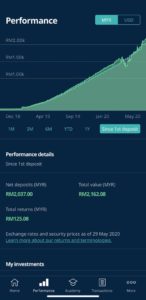
Due to my auto deposit plan and the quick recovery of the stock market, my portfolio value is now above RM2,000! The recent upturn has got me a net return of RM125 since inception. It’s nothing amazing, but I’m happy enough considering the situation we’re in.
I’ll continue with my monthly deposit plans and hopefully get this above RM3,000 real soon 🙂
Now, let’s go through what has been changed.
Changes From The StashAway Portfolio Re-optimization

On a high level view, we see that a lot is going on. Allocations for international equities have increased at the expense of much lower ones for US equities. We’ll deep dive into this a bit later.
They’ve also introduced real estate assets (REITS)! These are usually high dividend yielding investments with little volatility to their names.
In recent times, companies like Facebook & Google have announced that their employees will be allowed to work from home for the remainder of 2020. CEO of Twitter & Square, Jack Dorsey took this one step further. He’s allowing his teams to work from home perpetually, meaning they’d never have to return to office!

This doesn’t bode well with REITS, especially those in the office leasing area. As more companies realise that they don’t need an office to operate, they’d happily take the cost savings remote jobs provide!
For commercial REITS like shopping malls, I’m thinking digitalization and e-commerce will ramp up and the presence of physical stores will start to decline after this. Not many would want to go to shopping malls to chill out, things wouldn’t really be the same.
This is of course merely my opinion, and things could pan out very differently. Maybe a vacant office space would be snapped up quickly. Maybe people miss going out that they’d start flocking to malls as soon as lock downs are lifted. Who knows?
After all, REITS only account for 6-8% of my portfolio, so no big deal!
Similarly, they’ve introduced commodities (Gold) to my portfolio. It seems like they’re going risk averse mode as even the highest risk portfolio (mine) has a 16-24% allocation in gold.
In case you didn’t know, gold has always been considered a safe haven asset or an inflation hedge. It’s not meant to generate the high returns that signifies a high risk portfolio.
Well, it’s difficult to argue when gold has a one year return of 35%. That trumps the S&P 500 by miles. I guess it’s in line with their fears of the devaluation of the USD due to excessive money printing.
I would have preferred a smaller allocation to gold than this personally. 20% seems a bit excessive for a growth portfolio. Bitcoin, anyone?
StashAway Portfolio Re-optimization – International Equities

They’ve introduced 2 new ETF’s; Chinese Tech & Emerging Markets and reintroduced an ETF that got removed before; All Asia Except Japan.
Notable stocks that are in these ETF’s include Alibaba, Tencent, Baidu, & Pinduoduo.
To accommodate for this, StashAway completely sold out of their European & American investments.
Now this is what I call a bold move. On the US portion specifically; the S&P 500 is the cornerstone of most investment portfolios. And it’s hard to argue against that concept. The ETF holds positions in the 500 largest companies in the US and has been providing consistent growths over the long term.
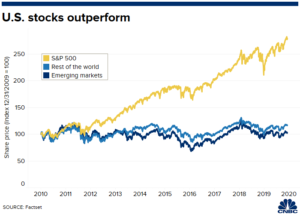
Over the last 5 years, the S&P 500 has generated ~9% in returns annually. In comparison, the Chinese Tech, Emerging Markets, & Asia ex-Japan ETF’s have returned ~5%, ~0.8%, and ~0.5% respectively.
This pales in comparison. We need to of course bear in mind that past performance is not an indicator for future results. Just because an investment has generated 10% over the last 50 years does not mean it will do so in the next 50.
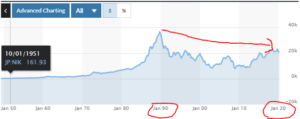
Things could pan out like Japan where the stock market hasn’t recovered after more than 30 years. Could the US be in a massive price bubble?
This is a move that could backfire on StashAway. They could’ve just stayed the course and remained their investments in the US and not many would have complained.
They must have identified a significant overvaluation in the US stock market coupled with an undervalued Asian market. And I don’t disagree with this. However, it’s important to remember that just because something is overvalued doesn’t mean it will fall and vice versa.
The market isn’t as efficient as that. In 2010, 1 share of Amazon was $180 and by many metrics was overvalued. People were egging on investors as the stock priced way above their current eranings. Today, Amazon is worth $2,400 a share – a growth of over 1,000%. Markets are forward looking, it prices in growth potentials so it’s incredibly tough to call where it ends.
I’m not saying that a rotation wouldn’t happen, but the question is when? What happens if the US stock market continues on their massive bull run while the Asian market lags behind? How long can StashAway stick to their guns?
Having said all this, I like this move from StashAway. Whether it pans out or not, no one knows. This is the exact reason I’m putting my money here over a standard index fund. Index funds don’t do market analysis and identify shifts in trends.
StashAway is supposed to. To add on to this, I already have a US heavy stock portfolio so some exposure to other markets is nice. If you want to follow my portfolio, check out my YouTube video here!
StashAway Portfolio Re-optimization – US Equities

In line with the above, the US equities portion of this portfolio has reduced by 25-40%. They’ve maintained investments in Consumer Discretionary & Small Cap stocks, reduced Healthcare, & removed energy, communication, & technology.
Again, a bold move by StashAway. In a digital world with life changing innovations happening constantly, technology leads the way. More specifically, US technology.
Of course, this is being replaced by the Chinese Technology ETF as mentioned above. However, what this means is that the portfolio no longer holds positions in the likes of Microsoft, Facebook, & Apple.
These companies may already have massive valuations and could potentially be overvalued, but not many are eager to bet against them. Apparently, StashAway is.
This is an acceptable change as healthcare & small cap stocks do have their own potential.
Not gonna lie though, I still love my US Technology stocks. I’d rather them over any of the other 3 that are still there! I do admit that these companies have had their runs over the past decade and a rotation should be on the cards.
Just need to remind myself that at one point, Exxon Mobil was the largest company in the world with a market cap of >$500B. Today, they’re worth “only” ~$130B.
Having gone through this, I wanna share some thoughts on these changes.
Potentials
1. Many investments groups ARE shifting towards China
I’ve read my fair share of articles. And I’ve realized that a lot of them have a bullish call on China & Gold. It’s probably something I’m overlooking, but it’s comforting to know that StashAway is in good company.
2. Chinese stocks are undervalued versus US stocks
Many Chinese companies are valued way lower than their US counterparts. Take an example of Alibaba vs Amazon, 2 e-commerce giants.
Amazon has a PE ratio of 116, meaning investors are willing to pay $116 for every $1 Amazon makes in profits. Usually, investors are only willing to do this if they see massive potential in the company’s future. Well, Amazon is already worth $1.3 Trillion. Yes, trillion.
On the other hand, Alibaba has a PE ratio of only 25. They’re known as the Amazon of China and operate in many of the same spaces. Yet, they’re valued less than a quarter of Amazon in this metric.
Granted Amazon is probably further ahead in their other services, is there a possibility that the ratios start to converge into the middle aka Alibaba sees a nice rise upwards?
3. China is a growing economy

China’s GDP has grown in the 5-10% mark over the past 10 years. In the same period, the US GDP has fluctuated between 0-4%.
The potential for China lies in their massive population and more specifically, a rising middle class. With many of their citizens still sitting in the lower income bracket, China’s growth in manufacturing, technology and services should play a role in pushing income levels up.
As you have more people earning more money, they start to consume more. This leads to greater profits for companies, higher taxes for the government, and a good looking stock market.
Considerations
1. De-listing of Chinese stocks
Donald Trump is infuriated with China. Or maybe he’s just intimidated. Regardless, they’re looking at a bill to de-list Chinese companies from US stock markets. What this means is that Chinese companies will not be allowed to list their shares on the US stock exchanges.
This could lead to a massive outflow of investments (people sell their Chinese stocks) as the US stock markets are the epicenter of global investments. It’s why so many companies want to list there.
However, not all hope is lost. Companies like Tencent proves that you don’t have to be listed in the US to be popular among investors and provide massive growth. Over the past 5 years, the stock has increased 150% on the Hong Kong stock exchange. Not too bad, eh? With this portfolio re-optimization, we’d in a way be shareholders of Tencent!
2. Authenticity of Chinese companies
Investors don’t seem to trust Chinese companies. They don’t report their numbers at the same accounting standards as their US counterparts for some reason.
Just recently, a Chinese company dubbed the Starbucks of China admitted to tailoring their accounting reports. The share price dropped from $50 a share in January to $2 a share today.
We also need to remember that just because we trust a company, not everyone will share our views. Hence, a company’s shares may not go up even if they have solid earnings report if investors are skeptical.
This could hinder potential growth in the China region as they try to build themselves as a trusted & noteworthy place for investments.
3. Trade War & Shift In Appetite
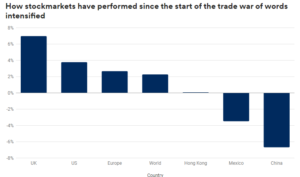
An ongoing trade war between US & China will undoubtedly hurt both economies. However, I’m of the opinion that the latter will be worst off. Chinese exports will be impacted as taxes increase on these goods.
Another possible change that we could see stems from the pandemic. When China went into a nationwide shutdown early in the year, companies like Apple faced massive supply chain problems. Many of their manufacturing plants were based in China, and the lock down meant no products were being built.
As such, they’ve started to realize that having your entire supply chain dependent on one country is probably not a good idea. Vietnam has been touted as a potential replacement for a portion of their manufacturing, with some AirPods reportedly already being made there.
With this in mind, the Chinese economy might see a hiccup if mega corporations start to diversify their manufacturing plants a bit to protect themselves. GDP growth will slow down and the potential I mentioned above could be reduced.
Conclusion
StashAway is making a bold decision in shifting their portfolios from the popular US market to the less so Asian market. Moreover, the removal of Technology stocks means we no longer have exposure to some of the biggest technology companies in the world like Microsoft & Apple.
However, there is a lot of potential in China & other Asian countries. This could prove to be a genius move but there’s no way to know for sure. Regardless, it’s always better to invest than not!
If you haven’t signed up with StashAway, use our link to enjoy 50% off your management fees for 6 months!
Enjoyed reading this article? Share it with your friends! It’d be mean a lot to us 🙂
Other reads:

